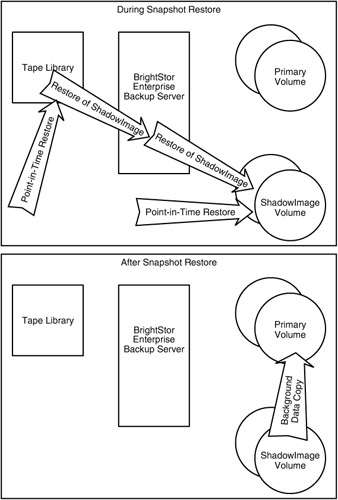Storage Evolution
|
| < Day Day Up > |
|
The storage-evolution approach to data protection has already been accomplished in BrightStor EB (Exhibit 2) and represents the probable direction of backup and recovery evolution on Windows in the foreseeable future. While it is already available for organizations using SQL Server 2000, it is currently being integrated with the upcoming releases. Windows Server 2003, for example, will include Volume ShadowCopy Service (VSS) and Virtual Disk Service (VDS), which allow interoperation and cooperation between storage hardware, storage software, and business applications. VSS lets vendors plug in snapshot, clone, and data replication solutions and allows integration with other applications. VDS, on the other hand, simplifies the configuration of direct-attached storage and storage area networks (SANs) by providing a standard way to interface with storage devices.
Exhibit 2: During and After Snapshot Restore

Further, everything learned by engineers and developers during the integration and benchmarking of the BrightStor offering (Exhibit 3) has been carefully documented. This information will be made available in a white paper that will be posted on Computer Associates' Web site (www.ca.com). Microsoft, Computer Associates, Hitachi Data Systems, and other storage leaders assembled some of the best minds in the field in one lab to figure out how to optimize Windows recovery speed and minimize backup overhead. In addition to the results disclosed above, these benchmark studies led to a large collection of lessons learned, which will soon be posted in the public domain, including in-depth research into how various parameters such as database size and the number of channels affect storage performance. The paper also offers insight into the various ways in which this architecture may be of benefit to smaller environments as well as non-Windows environments. While much of what has been discovered relates directly to large enterprises operating exclusively on a Windows platform, a surprisingly large number of best practices have been found to apply to small and mid-sized organizations.
Exhibit 3: BrightStor Offering: Fastest Ever Database Backup/Recovery Performance on Distributed Platform
Sustained throughput during backup: 2.6 TB/hour
Sustained throughput during restore: 2.2 TB/hour
Time to back up 2.5-TB database to tape: 68 minutes
Time to restore 2.5-TB database: 11 minutes
Average CPU utilization across 8 CPUs on backup server during backup: 26 percent
Average CPU utilization across 8 CPUs on backup server during restore: 12 percent
Average CPU utilization on database server during backup: 51 percent
Transactional load on database server during backup: 983 transactions/second
The results of the research were achieved using Microsoft's SQL Server 2000 Enterprise Edition (consisting of 32 × 80-GB data files in one file group) running on a Unisys ES7000 Orion 230 server (divided into one database server partition and one backup server partition) utilizing the Windows 2000 Datacenter Edition operating system. A SAN used the Hitachi Data Systems Lighting 9980 storage subsystem with Fibre Channel disk drives (32 RAID-10 volumes each consisting of 4 drives), four Brocade Silkworm 3800 fabric switches (2 Gb/sec), and two Quantum ATL P7000 tape libraries configured with a total of 32 LTO Ultrium tape drives connected to the Unisys server via 24 Emulex LP9002 Fibre Channel host bus adapters (HBAs; 16 HBAs on the backup server partition and 8 HBAs on the database server partition). Computer Associate's BrightStor EB and SQL Server Agent software exploited SQL Server's Virtual Data Interface (VDI), as well as ShadowImage technology from Hitachi Data Systems to ensure consistent snapshot backup and restore of the database (Exhibit 4).
Exhibit 4: Test System Environment

While this white paper represents the release of a substantial amount of data, it is only the start. The next phase will be the issuance of a series of more detailed publications and services outlining best practices for the configuration and sizing of a wide range of storage environments.
Microsoft System Restore
Snapshot technology is not a new addition to Windows. Its first appearance was in the System Restore function embedded into Windows Me and XP as a means of restoring system configuration in the event of a problem resulting from the installation of new software or drivers. In that case, System Restore is used to go back to a previous point in time, and a good configuration is restored. System Restore technology is really a subset of snapshot technology as it does not take a snapshot of data files, only some system files and the Windows registry. System Restore requires a minimum of 200 MB of disk space and defaults at 12 percent of disk space. It is also a resource hog. Every time the system is started up, System Restore is actively taking a snapshot and writing data to disk of your current configuration. It takes a snapshot every ten hours and any time anything changes, so it makes loads of unnecessary copies and is not really of value as it discards old snapshots after a few weeks. For example, I decided to use it to remove an annoying message I could not get rid of that pops up after startup asking me to download the latest version of Yahoo Companion. This message would not go away no matter what I did. I decided to use System Restore to go back to the point in time before I downloaded the application that brought with it the annoying message. When I tried to revert to the previous system state, I discovered that I had about 100 snapshots available for my computer — one every ten hours for two months but none from three months ago when I had added the application in question to my system.
|
| < Day Day Up > |
|
EAN: N/A
Pages: 197